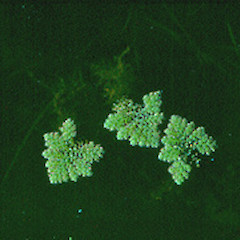Azolla pinnata
Common name
ferny azolla
Synonyms
Azolla pinnata subsp. asiatica
Family
Salviniaceae
Flora category
Vascular – Exotic
Structural class
Ferns
NVS code
The National Vegetation Survey (NVS) Databank is a physical archive and electronic databank containing records of over 94,000 vegetation survey plots - including data from over 19,000 permanent plots. NVS maintains a standard set of species code abbreviations that correspond to standard scientific plant names from the Ngä Tipu o Aotearoa - New Zealand Plants database.
AZOPIN
Conservation status
Not applicable
Brief description
A small aquatic free floating perennial fern which forms a conspicuous red (green in shaded areas) mat on the water surface. Plants are 1–3 cm long, triangular in outline, and regularly branched. Leaves green to red. Roots densely covered with branched, fine, hair-like rootlets.
Distribution
Introduced and Naturalised. new Zealand: North Islabd (abundant in the north to the Rotorua Lakes with scattered sites further south to Levin). Indigenous to Africa, Asia, Australia.
Habitat
Still and slow flowing water bodies in warm areas.
Wetland plant indicator status rating
Information derived from the revised national wetland plant list prepared to assist councils in delineating and monitoring wetlands (Clarkson et al., 2021 Manaaki Whenua – Landcare Research Contract Report LC3975 for Hawke’s Bay Regional Council). The national plant list categorises plants by the extent to which they are found in wetlands and not ‘drylands’. The indicator status ratings are OBL (obligate wetland), FACW (facultative wetland), FAC (facultative), FACU (facultative upland), and UPL (obligate upland). If you have suggestions for the Wetland Indicator Status Rating, please contact: [Enable JavaScript to view protected content]
OBL: Obligate Wetland
Almost always is a hydrophyte, rarely in uplands (non-wetlands).
Detailed description
Tiny free-floating aquatic fern, forming red-coloured mats (green in shaded areas). Plants 25 × 20 mm, triangular or 5-angled in outline, regularly branched. Leaves usually not overlapping, green turning red. Roots to 5 cm long; with fine, lateral rootlets.
Similar taxa
Azolla rubra—a native floating fern. A. rubra is more ovate and irregularly branched. Rootlets are and unbranched. In comparison A. pinnata has regular 2 pinnate branching and its roots have fine rootlets.
Life cycle
This perenniel reproduces rapidly by fragmentation, forming dense mats across nutrient-rich still waters. Produces spores which may be spread by waterfowl.
Other dispersal mechanisms include downstream via waterflow and into new catchments via contaminated diggers, eel nets, boats and trailers, water fowl, occasionally by wind blown spores.
Year naturalised
1969
Origin
Tropical Africa, Asia, Australia
Reason for introduction
Possibly contaminant of ornamental pond plants, or a natural introduction from Australia being spread by migratory waterfowl.
Control techniques
Can be managed using floating booms that push floating plants to one end of a dam or small water body, then remove manually/mechanically. Only short-term control usually achieved.
Tolerances
Tolerates low to high nutrient water, high to moderate temperature. Intolerant of low temperatures and heavy shade. Does not dominate in moving water or expose surfaces.
Etymology
azolla: From the Greek azo ‘to dry’ and ollo ‘to kill’, killed by dryness
pinnata: From the Latin pinna ‘feather’, in botany pinnatus ‘pinnate’ refers an arrangement of leaves, veins or branches in rows along a central axis, similar to the structure of a feather.
Attribution
Factsheet prepared by Paul Champion and Deborah Hofstra (NIWA).
References and further reading
Champion P. et al. 2020. Freshwater Invasive Species of New Zealand 2020. NIWA publication. https://docs.niwa.co.nz/library/public/FreInSpec.pdf
Coffey BT, Clayton JS. 1988. New Zealand water plants: a guide to plants found in New Zealand freshwaters. Ruakura Agricultural Centre, Hamilton, NZ. 65 p.
Johnson AT, Smith HA. 1986. Plant Names Simplified: Their pronunciation, derivation and meaning. Landsman Bookshop Ltd, Buckenhill, UK.
Johnson PN, Brooke PA. 1989. Wetland plants in New Zealand. DSIR Field Guide, DSIR Publishing, Wellington, NZ. 319 p.
Popay I, Champion P, James T. 2010. An illustrated guide to common weeds of New Zealand, 3rd edition. NZ Plant Protection Society Inc, Christchurch, NZ. 416 p.









